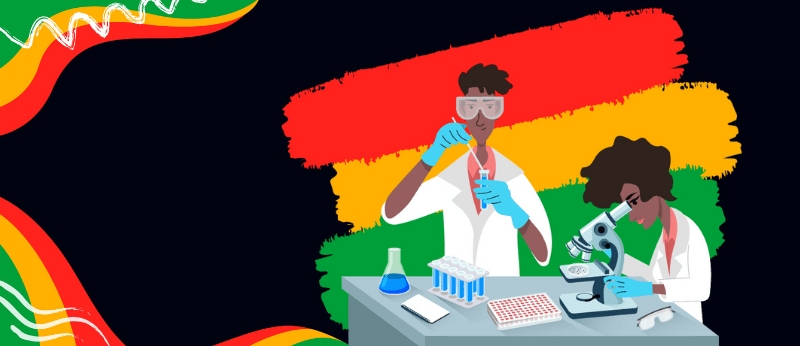Marking Black History Month 2024 with Oncology Central

With February marking Black History Month (BHM), we have compiled a collection of articles from our digital hubs. These articles delve into the achievements and groundbreaking research of Black scientists, highlighting the importance of representation and equal opportunities in STEM.
By fostering open and honest conversations, our aim is to highlight the experience of Black individuals in STEM, ultimately striving to contribute to a more inclusive and diverse scientific community.
Oncology Central
Why are certain populations at a greater risk of developing cancer? – Wayne Lawrence shares insights into his research on cancer risk and disparities. He explains how his dedication to understanding population-specific challenges aims to influence policy development and public health interventions.
Uncovering the link between cancer disparities and climate change – In this podcast episode, Kilan Ashad-Bishop speaks about the disparities that exist in cancer screening and how this can impact patient outcomes.
BIPOC involvement in oncological research: insights from Future Oncology – This special edition of Editor’s highlights by Michael Bell delves into recent publications from Future Oncology that emphasize the need for greater engagement and representation for Black, Indigenous and People of Color (BIPOC) people in oncological research.
Bioanalysis Zone
Black History Month: an interview with Rene Fuanta – Rene Fuanta discusses his career, greatest achievements and the useful resources he has used when facing challenges in his career.
Black History Month: an interview with Lauren Bailey– Lauren Bailey shares her motivation for pursuing a scientific career and offers advice to young Black scientists to help them thrive in the scientific field.
Enhancing bioanalysis efficiency via automated processes – In this webinar, Issa Jyamubandi explores case studies involving anti-drug antibody, neutralizing antibody, pharmacokinetic and biomarker assays, showcasing the successful application of the KingFisher™ in automating bead processing steps.
BioTechniques
Childhood trauma and its multigenerational impact on the brain – Leland Fleming speaks to us about how an individual’s childhood trauma affects them in adulthood and whether trauma can be transmitted to the next generation, either biologically or through behaviors such as parenting behaviors.
Integrative omics for characterizing addiction and brain development – Melyssa Minto discusses her research, the challenges of integrating complex, multi-layered data, the future of multiomics and what it means to be a multiomic bioinformatician.
Investigating the molecular pathways underlying variable risk of Alzheimer’s disease – Jamaine Davis highlights his work exploring genetic variation in proteins associated with Alzheimer’s and how these variants may help to paint part of the picture that explains how and why African Americans have an increased risk of developing Alzheimer’s disease. Jamaine also reflects on the impact that mentoring has had on his career.
Innovations for accessibility: developing HIV-1 diagnostic and monitoring technologies – Catherine Kibirige delves into her motivation to pursue HIV-1 research and provides insights into the technologies she’s developing to make early diagnosis and treatment-monitoring of the disease more accessible.
Investigating essential biomolecular pathways with cutting-edge techniques: time-resolved single-molecule biophysics methods in action – In this webinar, Sharonda Johnson LeBlanc explores the use of time-resolved fluorescence microscopy and spectroscopy to monitor key biomolecular interactions and dynamics.
Investigating mitochondrial–ER tethering in skeletal muscle cells – In this webinar, Antentor Hinton discusses the impact of OPA1 deletion in skeletal muscle on mitochondrial–endoplasmic reticulum (ER) tethering and the electron microscopy techniques used to investigate these mitochondrial–ER contact sites.
RegMedNet
Building bone from scratch: an interview with Ronke Olabisi – Ronke Olabisi discusses her journey into tissue engineering and how she uses biosynthetic materials to construct a diversity of tissue types.
Developing citrate-based biomaterials: an interview with Guillermo Ameer – Guillermo Ameer shares insights into the development and applications of citrate-based biomaterials in regenerative medicine and explores the considerations for clinical translation.
Expanding the horizons of cell and gene therapy: an interview with Nisha Durand– Nisha Durand delves into her work on mesenchymal stem cell therapy for intracerebral hemorrhage and reflects on the people who have played a pivotal role in influencing and shaping her scientific career.
This year’s BHM theme focused on ‘African Americans and the Arts’. In line with this, we hosted an art competition to celebrate the impacts that Black individuals have had on visual arts and scientific advancements. We saw entries celebrating a range of Black individuals in the scientific community including Robert A. Copeland Jr and Mae Jemison. The winning artwork depicted HeLa cells, honoring the profound impact Henrietta Lacks’ story has had on the policies around the use of immortalized cell lines for biomedical research.
Check out our article here as we reflect on the legacy of Henrietta Lacks.